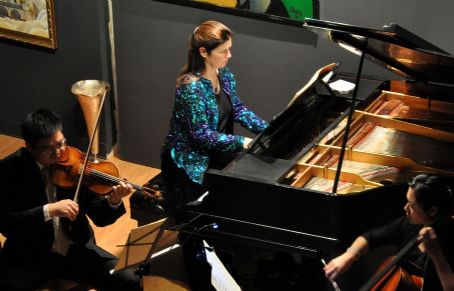|
Symphony
FROM THE NEW WORLD TO THE OLD WORLD
by Peter Lert
Saturday, June 14, 2025
Chamber
MC2 DUO RECITAL CLOSES 222'S SEASON
by Terry McNeill
Saturday, June 14, 2025
Choral and Vocal
CANTIAMO SONOMA'S LUSCIOUS A CAPELLA SINGING IN SEASON ENDING CONCERT
by Pamela Hicks Gailey
Sunday, June 8, 2025
Symphony
SRS SEASON ENDS WITH RESOUNDING TA-TA-TA-BANG
by Terry McNeill
Sunday, June 1, 2025
Symphony
YOUTHFUL VIRTUOSITY ON DISPLAY AT USO'S MAY CONCERTS
by Peter Lert
Saturday, May 17, 2025
Symphony
MYSTICAL PLANETS AND LIVELY GERSHWIN ORTIZ AT FINAL SRS CONCERT
by Peter Lert
Sunday, May 4, 2025
Symphony
VSO'S CONCERT MUSIC OF TIME, MUSIC OF PLACE
by Peter Lert
Sunday, April 27, 2025
VOCAL ELEGANCE AND FIRE AT THE 222'S RECITAL APRIL 26
by Pamela Hicks Gailey
Saturday, April 26, 2025
CANTIAMO SONOMA SINGS AN INSPIRED GOOD FRIDAY MOZART REQUIEM CONCERT
by Pamela Hicks Gailey
Friday, April 18, 2025
DRAMATIC SHOSTAKOVICH SYMPHONY CLOSES PHILHARMONIC'S 25TH SEASON
by Terry McNeill
Sunday, April 13, 2025
|
 |
 Chu-Pai-Walter Trio Playing Dvorak Dec. 31 in Petaluma (Lauren Silagyi Photo) |
CHU-PAI-WALTER TRIO RINGS IN 2012 AT PETALUMA HISTORICAL MUSEUM CONCERT
by Terry McNeill
Saturday, December 31, 2011
Musical detours can bring unexpected surprises, and on New Yearís Eve this writerís drive to Petalumaís Cinnabar Theater party stopped early for chamber music at the downtown Historical Museum. Sponsored by the Museum and the Sky Hill Cultural Alliance, the concert with gratis holiday refreshments featured two string players from San Francisco and local pianist Elizabeth Walter.
Handelís Passacaglia, the last movement of the G Minor Harpsichord Suite (BWV 432) was played in John Halvorsenís transcription by violinist Yun Chu and cellist Shu-Yi Pai. The acoustics favored Ms. Paiís rich sound and she frequently covered Mr. Chu in the early variations, the latterís unsteady with high register pitch problems. Things finally settled down as the compelling counterpoint unfolded, the pizzicato duo playing and deft phrasing impressive. The last variation was a frenzy of speed and notes and brought a loud ovation from the nearly full house.
Sky Hill Alliance Director Elizabeth Walter was the eveningís pianist, programming three Chopin works and Ginesteraís Op. 22 Sonata. Ms. Walter is a forceful artist with often a forced tone, the hallís instrument assisting with absence of treble overtones. The F Minor Study from the Trois Nouvelles Etudes was played with the right-hand melody triplets carrying well over the accompaniment, and briskly, as was the following C Minor Nocturne from Op. 48. A powerfully dramatic work with imposing octaves, the Nocturne received a capable but less-than-polished performance but one that conveyed agitation. Cascades of sound also characterized Ms. Walterís second Chopin Ballade in F, Op. 38. The alteration of folk-like charm and sonorous outbursts had the requisite drive from the artistís strong fingers and she held the damper pedal, after the long fortissimo carnage, into the eight-measure coda. An innocent and effective closure.
Ending the first half was the Ginastera from 1952, an odd choice for a New Yearís Eve concert with social components. The Classical Sonoma criticís rule book advises that the artist selects the works and the reviewerís job is to report on the playing. The Sonata, played from score, was a brawny and loud component to the evening and oneís mind turned to a bevy of more cordial works to spotlight the musical season. That said, the playing was the best solo work of the evening, the memory stumbles in the Chopin vanishing. In the first two movements the swirl of repeated notes, often in a toccata style, were distinct and recall Ginasteraís earlier Danza del Gaucho Matrero from the Danzas Argentinas. Arpeggiated chords in the Adagio molto appassiona had a mystical character reminiscent of the famous six-note Scriabin Prometheus chord, and the pianist caught the languorous nature of the music. The precipitato finale was potent, the off-beat accents contributing to the momentum and climatic conclusion. Not exactly party music but clearly an assured reading by Miss Walter. On this evidence she is a Ginastera champion.
Dvorakís popular Op. 90 Trio (Dumky) comprised the second half and had a great opening, Mr. Chuís singing line leading the way and Ms. Paiís cello again forceful. This six-movement work from 1890 is jammed with sharp contrasts, alterations of yearning melody and wild gaiety. There was a lovely threnody in the second movementís piano-violin duo and lyrical, bucolic playing in the vivacious Andante. The rolled chords at the end were chaste Dvorak and mesmerizing in the Trioís hands.
More movements unfolded, rhapsodic and Bohemian in the fourth and a fierce dance in the concluding Maestoso. Here Ms. Paiís cello rumbled and Ms. Walterís piano echoed the counterpoint and vitality.
Dvorakís Trio is a unique work, far different from contemporary trios of Mendelssohn, Rubinstein, Brahms and Tchaikovsky, and the Chu-Pai-Walter ensemble gave an impassioned and lucid performance. No encore was offered.
|

